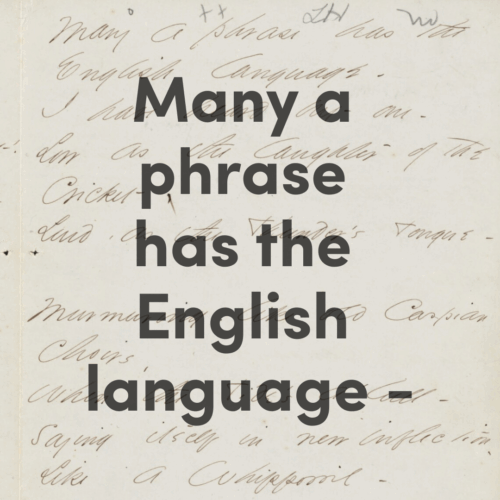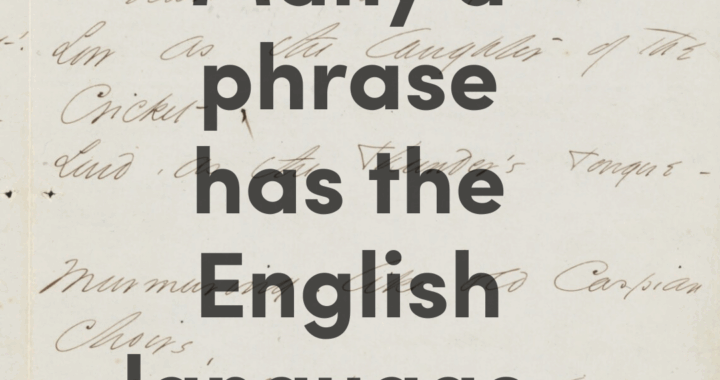“Many a phrase has the English language -“:
VIRTUAL PROGRAM
Join us for a virtual professional development program for educators exploring Dickinson’s manuscripts. This participatory zoom workshop will provide context and exercises that illuminate Dickinson’s frequently cryptic poetry. Attendees will leave this 90-minute session with new teaching strategies.
Registration is required and is offered on a sliding scale from $5 – $20. Please select the ticket price that is right for you and consider supporting the Museum and the participation of other educators through your purchase. Tickets are non-refundable.
You may request a Professional Development certificate upon registration.
View the full educator workshop lineup.
For any questions, please e-mail edmprograms@emilydickinsonmuseum.org

Because fewer than a dozen of Dickinson’s nearly 1800 poems were published during her lifetime, the poems we read and teach are rarely authorized or final texts. Dickinson’s original manuscripts sometimes exist in multiple versions; contain alternate words or phrases; are drafted on odd scraps of paper with striking shapes; and have line breaks different from the tidy quatrains with which they are usually printed. For example, in this poem that plays with the relation between the English language and the language of the natural world, Dickinson writes:
Breaking in bright Orthogra-
phy
creating an unconventional break in a line about breaking. This manuscript also includes alternate phrasings; she wonders whether the “push of Joy” in line 14 might instead be the “Pain of joy.” But Dickinson did not choose. There is no right answer to these manuscript questions. And that makes them a wonderful resource for teaching, for helping students get inside of Dickinson’s creative process, and for encouraging them to ask questions without fear of “getting it wrong.”
Join Karen Sánchez-Eppler for an interactive Zoom workshop discussing how to use Dickinson manuscripts in the classroom through the free Emily Dickinson Archive. The workshop will consider different approaches to the manuscripts, including poems that exist in variant versions, manuscript poems with alternate words, and those surprising, often visually stunning scraps an editor has dubbed her “radical scatters” and “gorgeous nothings.”
Many a phrase has the English language –
I have heard but one –
Low as the laughter of the Cricket,
Loud, as the Thunder’s Tongue
Murmuring, like old Caspian Choirs,
When the Tide’s a’lull –
Saying itself in new inflection –
Like a Whippowil –
Breaking in bright Orthography
On my simple sleep –
Thundering it’s Prospective –
Till I stir, and weep –
Not for the Sorrow, done me –
But the push of Joy –
Say it again, Saxon!
Hush — Only to me!
(Fr 333)
Karen Sánchez-Eppler has been a professor of American Studies and English at Amherst College since 1988, specializing in 19th century literature and history, and so has long ties both to Dickinson and to Amherst. Her first book Touching Liberty: Abolition, Feminism and the Politics of the Body (1993) concludes with a chapter on Dickinson. She recently served as co-editor with Cristanne Miller of The Oxford Handbook of Emily Dickinson (2022) and is currently writing a brief critical biography, Emily Dickinson / Critical Lives, for Reaktion Books. Another of her book projects in process The Unpublished Republic: Manuscript Cultures of the Mid-Nineteenth Century US considers 19th century manuscript projects more broadly. Her book Dependent States: The Child’s Part in Nineteenth-Century American Culture (2005) considers writing by children, most of which also only exists in manuscript form. That project helped spur the creation of the Historic Children’s Voices database at the American Antiquarian Society facilitating a teacher’s institute on its use in 2024 that will run again in August 2026. Her scholarship has been supported by grants from the NEH, ACLS, the Newberry Library, the Winterthur Library, the Stanford Humanities Center, and the Fulbright Foundation. She spent the 2019-20 academic year as Distinguished Scholar in Residence at the American Antiquarian Society, is one of the founding co-editors of The Journal of the History of Childhood and Youth, past President of C19: The Society of Nineteenth-Century Americanists, President of the Porter- Phelps-Huntington Foundation Board of Directors, and a longtime member of the board of the Emily Dickinson International Society and of the Emily Dickinson Museum’s Board of Governors.
